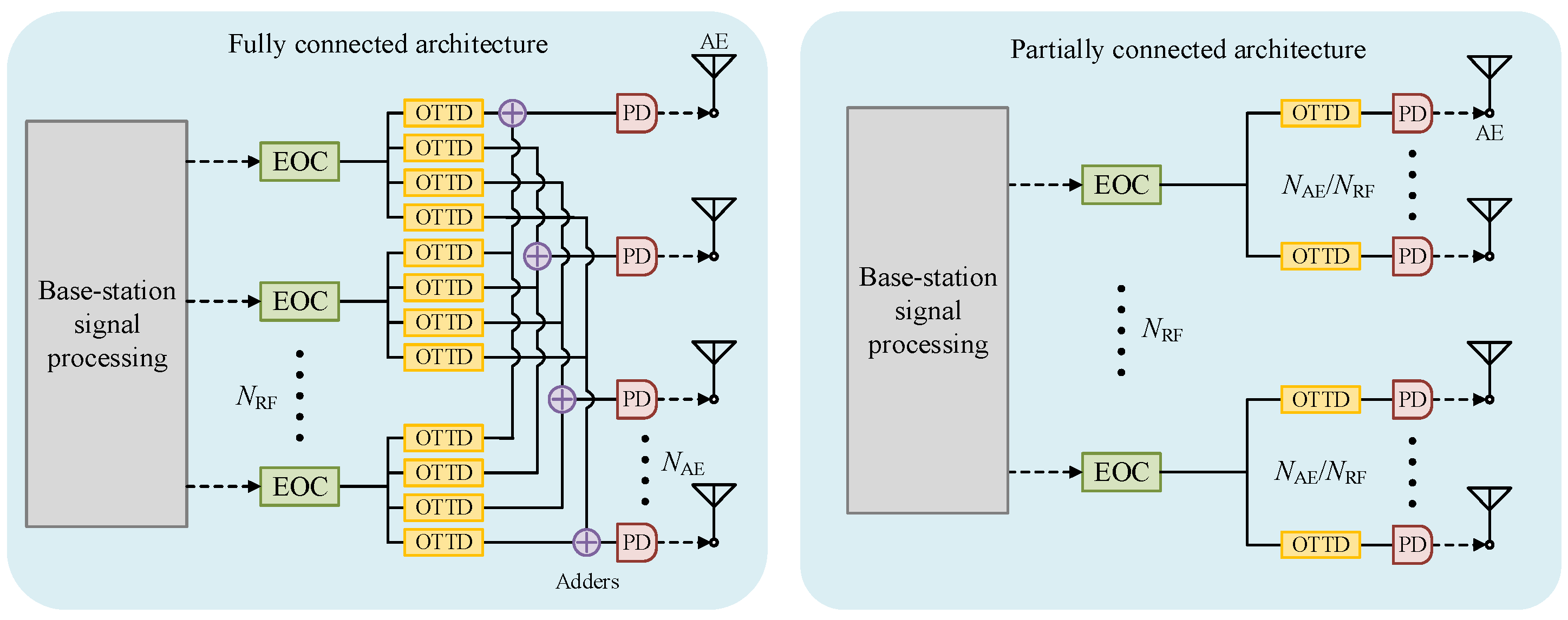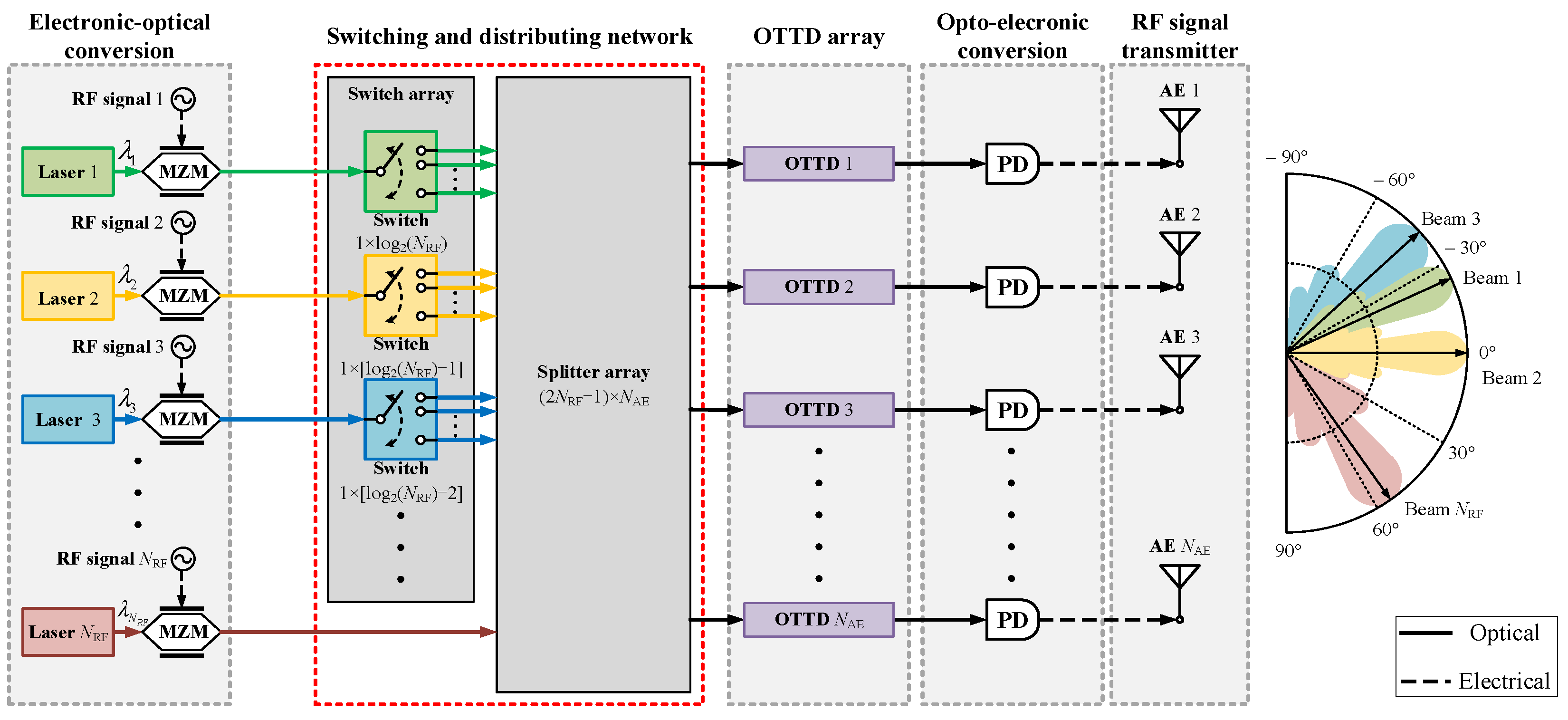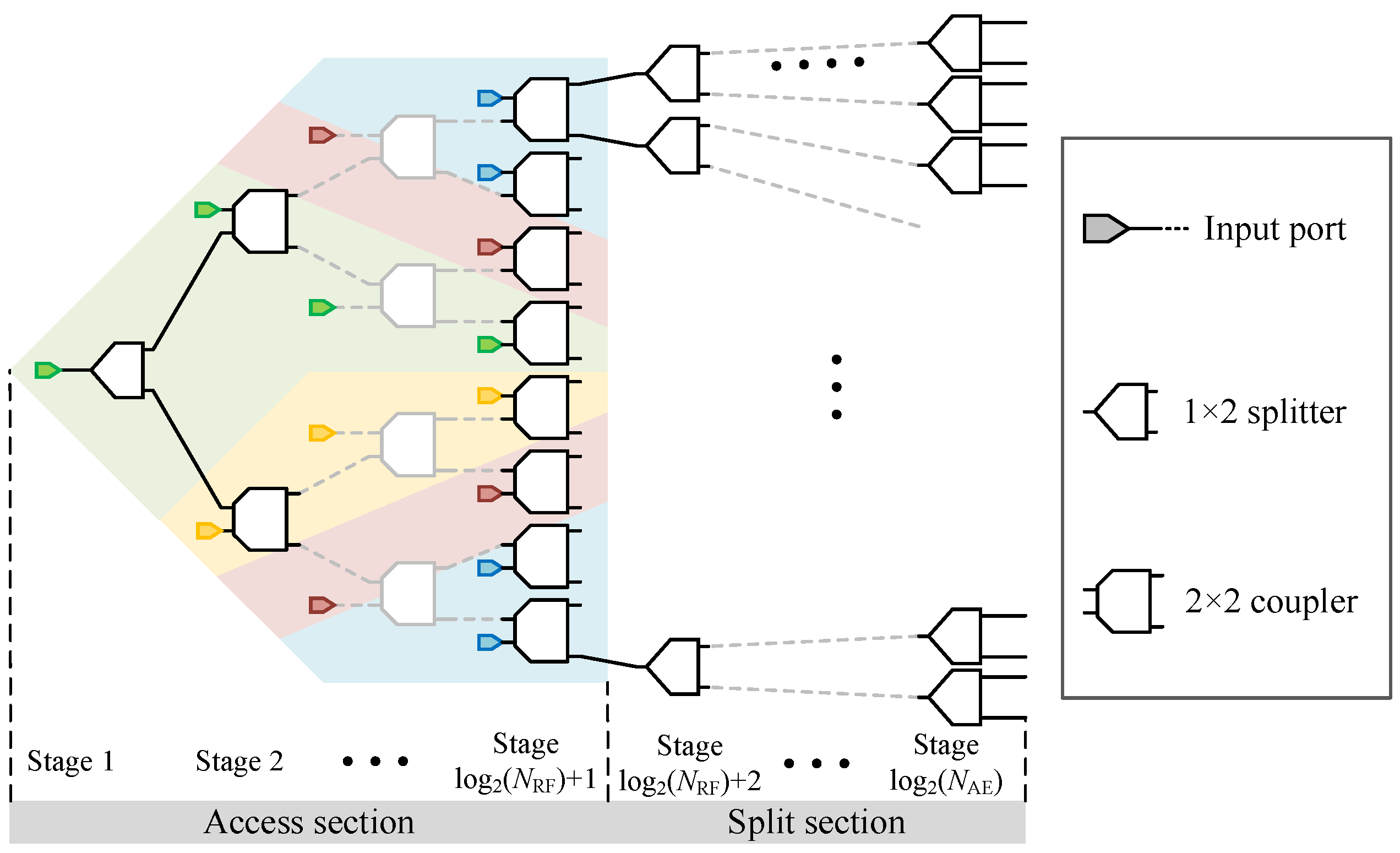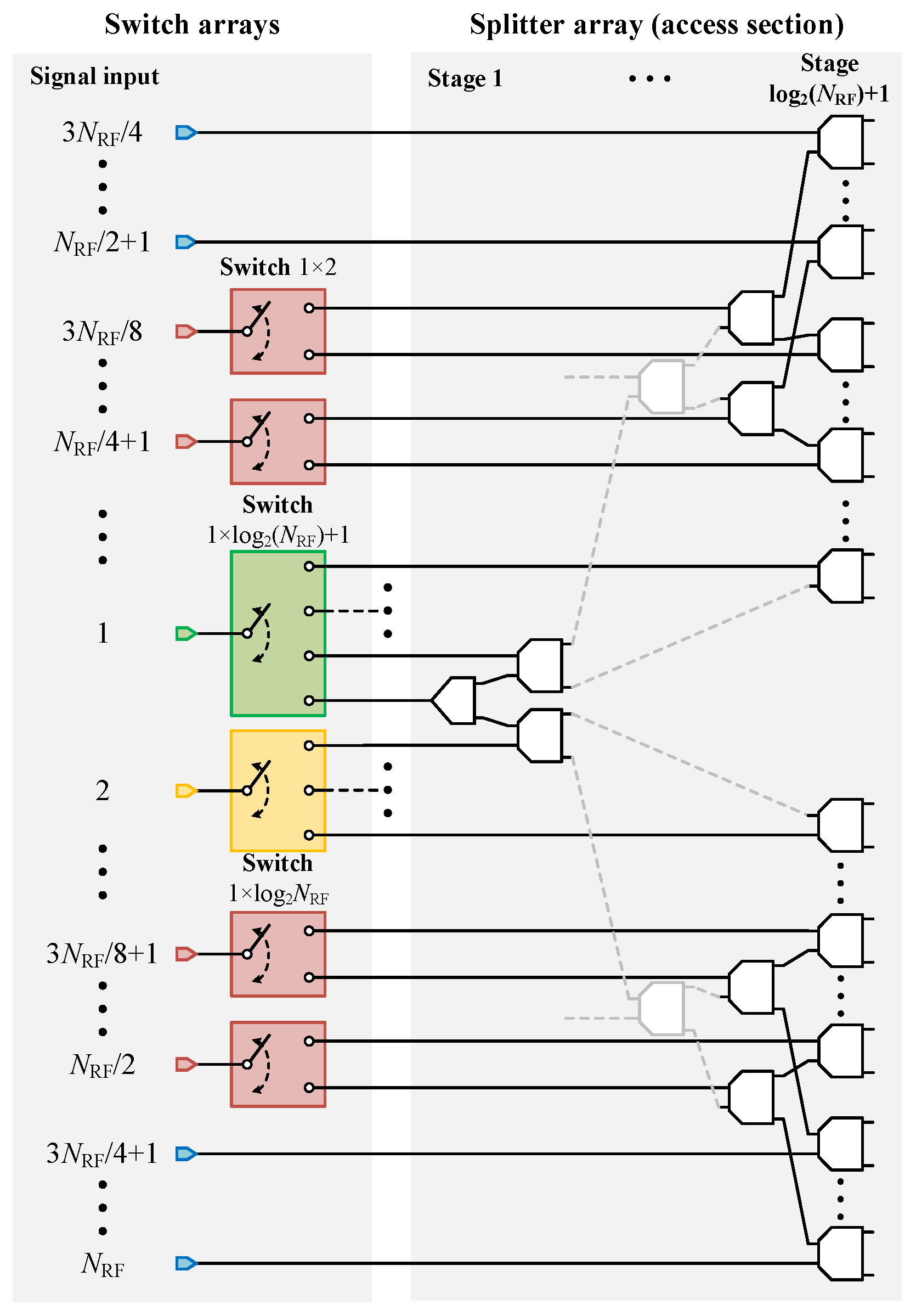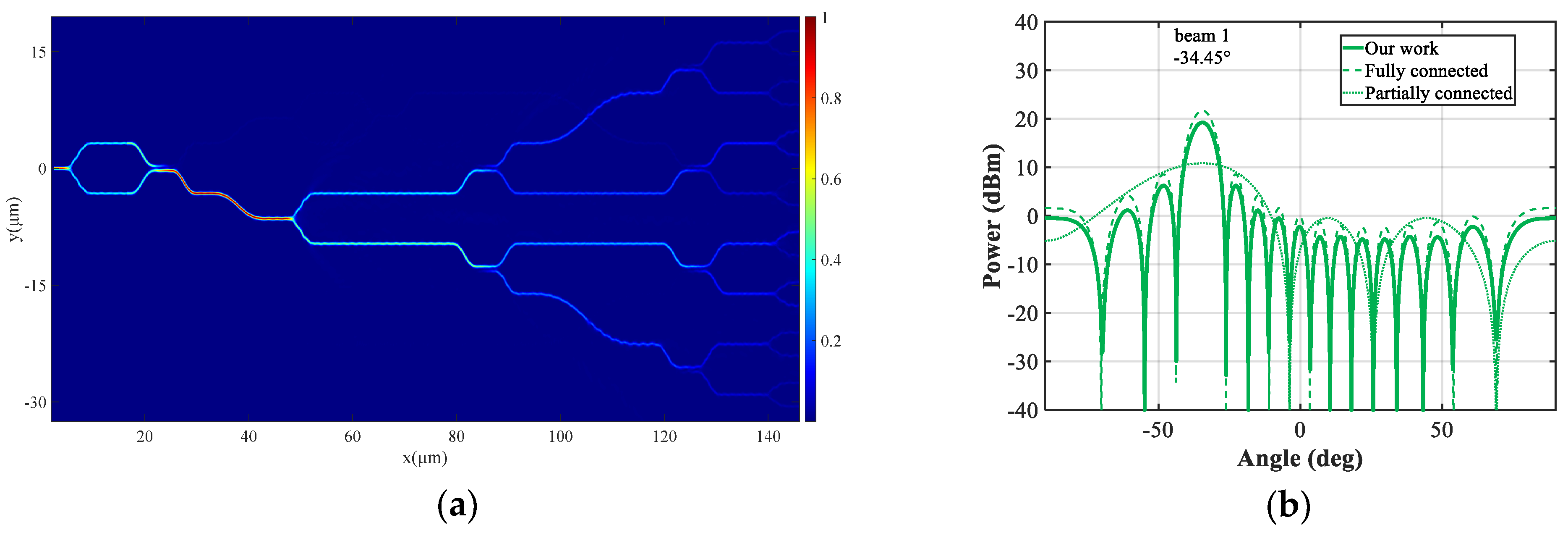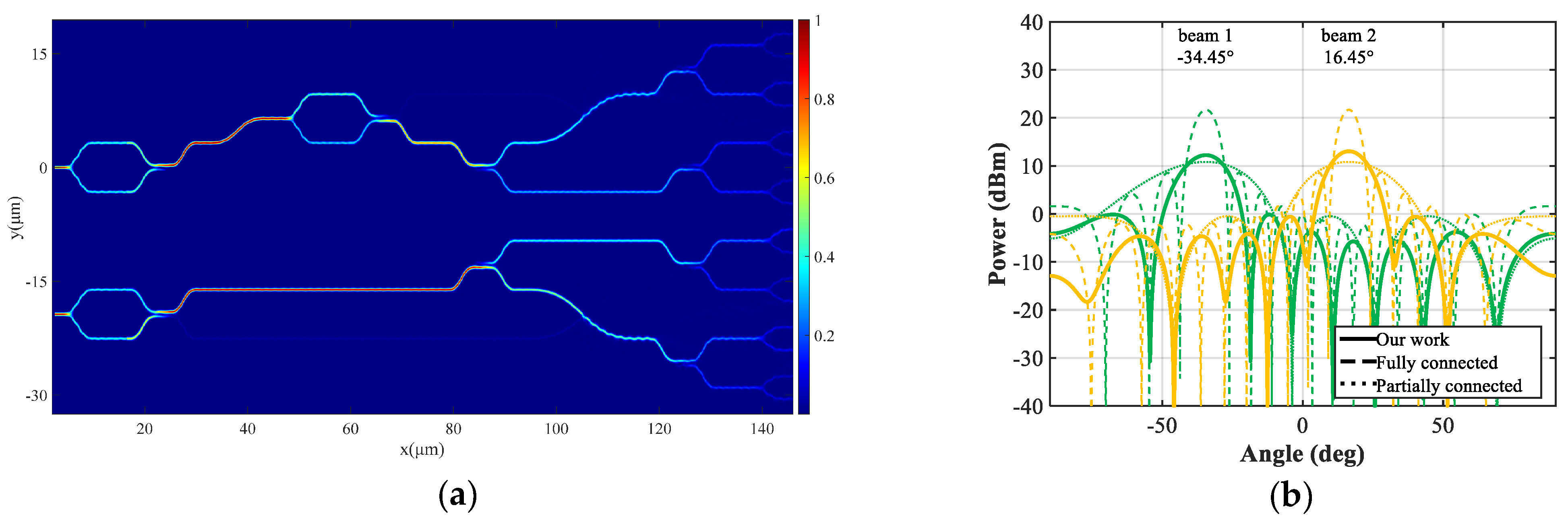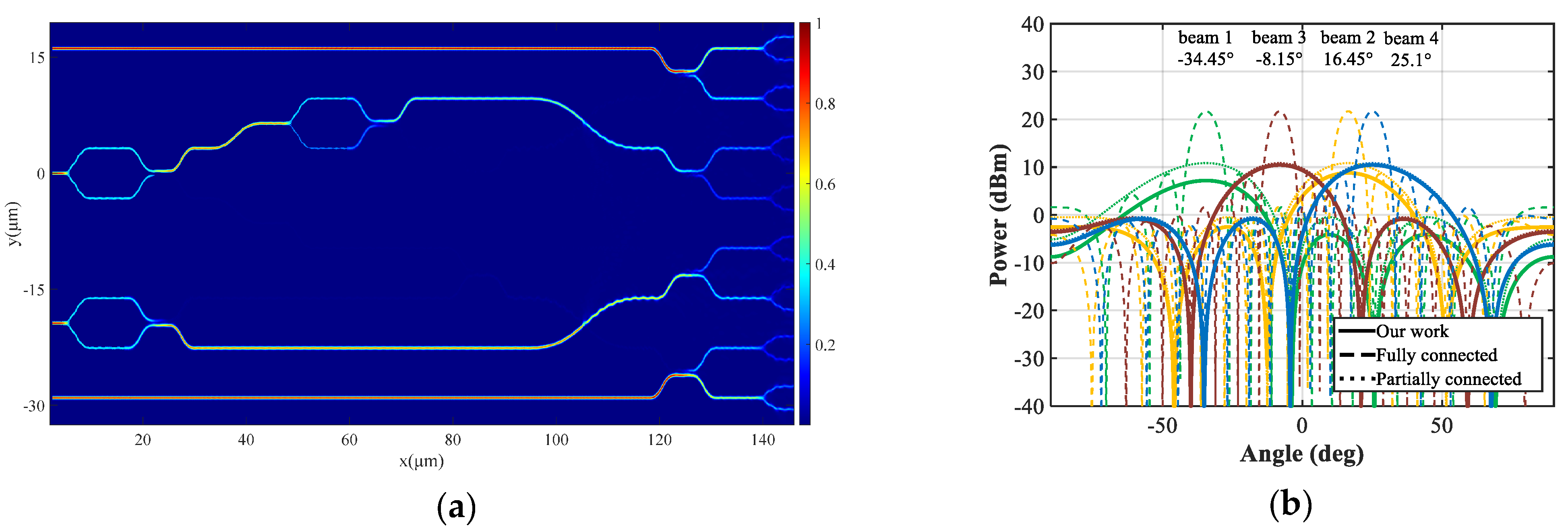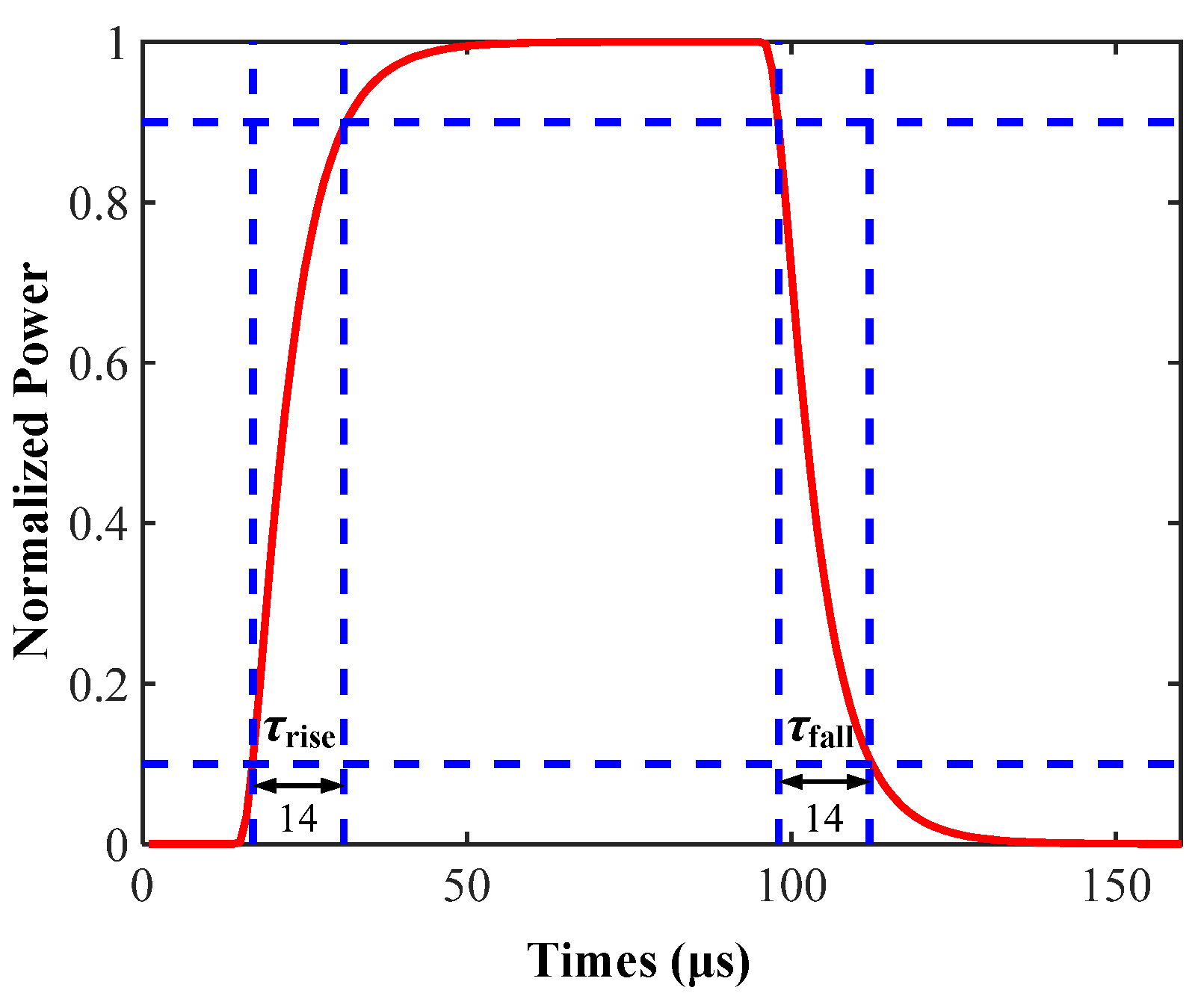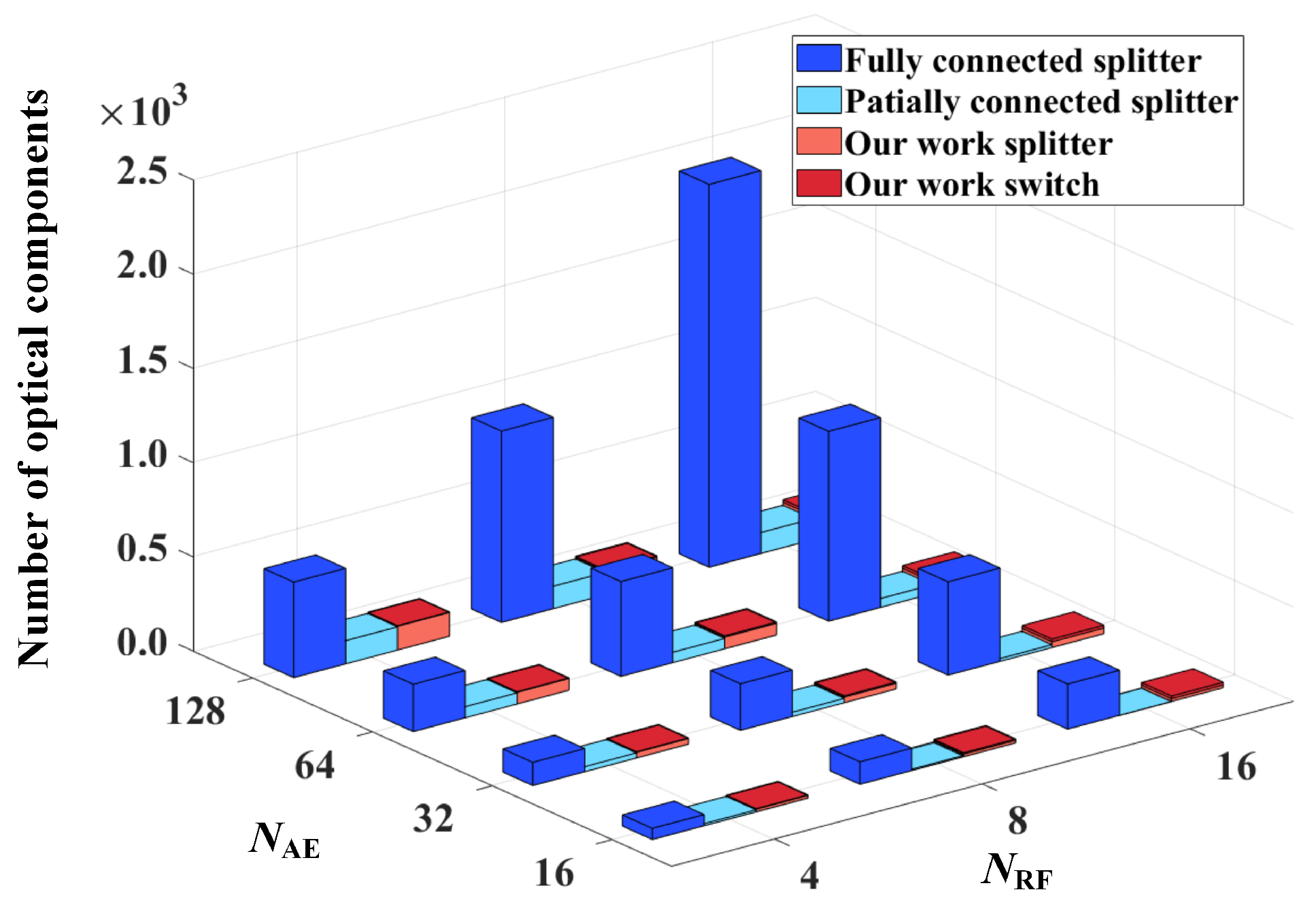The simulations validate the feasibility of SDN, which offers the reconfigurable connection between the RF signals and the AEs and enables the system to reconfigure the array subarray to transmit according to the number of input RF signals. Some discussions in detail are expanded based on the above simulations.
4.1. Transmission Analysis
In the photonic integrated circuit, component imperfections will affect system performance. The most significant impact is caused by the crosstalk of 1 × 2 optical switch elements, which creates several interferometers within the optical path. For example, in the optical path of signal 1, the interference is generated at the 2 × 2 coupler with two inputs connected to signal 1. The same interference occurs in the optical path of signal 2.
Set the crosstalk of the 1 × 2 optical switch to the typical value of 40 dB and simulate the 16 outputs transmission curves for three working modes. The simulation results are plotted in
Figure 11. As seen in
Figure 11, the transmission curves display slight wavelength dependence between signal 1 or 2 and certain outputs but do not impose limitations on the system broadband operation. However, during deployments, it is necessary to monitor the output of the optical switch to ensure its functionality and eliminate any optical interference. In addition, power compensation is needed because of the high insertion loss of optical components.
4.2. Reconfiguration Time
The time required for reconfiguration in SDN is an important parameter because the main deployment situations of the optical multi-beamforming based on SDN are future wireless communication or radar systems. The reconfiguration of SDN is realized by reconfiguring the optical switch array. Therefore, the time required for reconfiguration in SDN depends on the time needed for switching a single 1 × 2 optical switch. The optical switches, based on different principles, have different switching times. For example, the switching time required in the thermo-optical switch is at the micro-second level [
30]. As for the electronic–optical switch, the switching time is at the nano-second level [
31].
In the 4 × 16 SDN, shown in
Figure 6, three 1 × 2 optical switches are included. Therefore, when reconfiguring the working mode in SDN, a minimum of one 1 × 2 optical switch or a maximum of three 1 × 2 optical switches must be enabled. In the ideal situation, the time required for reconfiguration in SDN is equal to the time required for switching one single 1 × 2 optical switch. The 1 × 2 optical switch in the proposed SDN is realized in the thermo-optic effect. Many factors influence the switching time required for a thermo-optic switch, such as the material of the thermocouple, the parameter in the size of the thermocouple, and the distance between the thermocouple and the core of the waveguide. To simulate the switching time required for a single thermo-optical switch in the proposed SDN, the material of the thermocouple is set to nichrome, the size of the thermocouple is set as 2 μm in width and 0.12 μm in height, and the distance between the thermocouple and waveguide core is set as 2 μm. The simulation result is shown in
Figure 12. As can be seen in
Figure 12, the rise time,
τrise = 14 μs, is equal to the fall time,
τfall = 14 μs. Thus, in the ideal conditions, the reconfiguration time of the proposed SDN is 14 μs. This value is related to the specific parameter setup of the 1 × 2 optical switch. In addition, in the actual deployment, the time required for reconfiguration in SDN equals the longest switching time in three 1 × 2 optical switches.
4.3. Performance Comparison
The comparisons between the proposed and the two architectures in
Figure 1 are given.
The capability of beamforming is the key parameter in an optical beamforming system. To better compare the beamforming capability, three different beam pattern curves in three types of connected architecture are plotted in
Figure 8b,
Figure 9b, and
Figure 10b, respectively. In the three beam pattern plots, the same line color indicates the signal beam pointing towards the same direction, and the different styles of the line indicate the signal beam formed in different connected architectures. The solid line indicates the beamforming capacity of the proposed reconfigurable connected architecture. The dashed line indicates the beamforming capacity of the fully connected architecture. The dotted line indicates the beamforming capacity of the partially connected architecture. Some parameters are used to evaluate the beamforming capability, such as main lobe power, full width at half maxima (FWHM), and side lobe depression.
Firstly, the proposed reconfigurable connected architecture in single-beam working mode has the same beam width and a similar sidelobe depression with fully connected architecture by comparing the data in
Table 7. However, the main lobe power of the proposed architecture is lower by 2.42 dB than the fully connected architecture. The reason is the high loss of the optical component in the SDN optical path.
Secondly, the proposed reconfigurable connected architecture in quadra-beam working mode has the same beam width and sidelobe depression as the partially connected architecture by comparing the data between four tables. Whereas, because of the high loss of optical components in the SDN optical path, the main lobe powers of the proposed reconfigurable connected are lower by 3.66, 2.06, 0.40, and 0.40 dB than the partially connected architecture, respectively. Therefore, based on the above two points, optical amplifiers are needed in the SDN optical path to compensate for the optical power and enhance the beamforming capability of the reconfigurable optical multi-beamforming based on SDN.
Lastly, by comparing the parameters of the proposed reconfigurable connected architecture in different working modes between four tables, the proposed reconfigurable connected architecture in single-beam mode has the highest main lobe power, the smallest beam width, and the highest sidelobe depression than the other working mode. Moreover, the proposed reconfigurable connected architecture in quadra-beam mode has the lowest main lobe power, the biggest beam width, and the lowest sidelobe depression. Therefore, the ability to focus the power in a signal beam is diminishing with the increasing number of input RF signals in the proposed reconfigurable architecture, which also means the reconfigurable multi-beamforming based on SDN has the variable beamforming gain, can reconfigure the capability of beamforming and adapting to the various RF signal transmission scenarios.
In addition to comparing the beamforming capability, the number of optical components in the connected architecture was also evaluated. These components include splitter elements and switch elements. The results are presented in
Table 11 below.
To instinctively comprise the number of optical components included in three architectures, the parameter sweeps with
NAE = 16, 32, 64, 128, and
NRF = 4, 8, 16 are performed, and the bar graph is shown in
Figure 13.
As can be seen in
Figure 13, the fully connected architecture has the greatest number of optical splitters compared to the others, which means it has the highest hardware complexity. The gaps in hardware complexity between the fully connected architecture and the other two architectures are increased with the number of input signals
NRF and the number of antenna elements
NAE increasing. Furthermore, the partially connected architecture has an approximate number of optical components similar to the proposed architecture.
In summary, compared to the fully connected architectures, the reconfigurable multi-beamforming system based on SDN maintains the highest beamforming gains while significantly reducing the hardware complexity. Compared to the partially connected architecture, the proposed architecture exhibits equivalent hardware complexity but can achieve greater beamforming gains. Thus, the proposed reconfigurable optical multi-beamforming system based on SDN offers more degrees of freedom and adaptability in a multitude of communication scenarios for the future.
4.4. Beam Steering Capability
The beam steering pattern simulations are performed to prove the integration of SDN will not influence the beamforming and steering capability of the OTTD array. In the parameter setup of
Section 3, the OTTD devices employed in our proposed system are the same as the devices in the architecture of
Figure 1, which can form eleven beams in different directions to cover the sector in ninety degrees.
Figure 14 is plotted to demonstrate the beam steering capability.
Figure 14a describes the beam steering of RF signal 1 with eleven beam directions when the proposed system works in single-beam mode.
Figure 14b illustrates the beam steering of RF signal 2 with eleven beam directions when the system works in dual-beam mode.
Figure 14c describes the beam steering of RF signal 3 (which equals RF signal 4) with eleven beam directions when the system works in quadra-beam mode. The beam parameters, such as main lobe power, FWHM, and side lobe depression under different situations, are listed in
Table 12,
Table 13, and
Table 14, respectively.
The powers of the main lobe and side lobe are constant over the direction of the beam by comparing the beam parameters in different directions. Meanwhile, the beam width will expand with the beam direction away from the normal, which means the radiative power focusing ability of the antenna array decreases as the beam pointing angle increases. As shown in
Figure 14, the different signals all formed beams pointing in eleven different directions under different SDN working modes. Therefore, the multi-beamforming architecture based on SDN can provide continuous beam steering.
